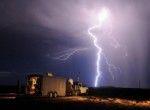Houston is the Capitol of Texas for lightning, that is.
Thousands of strikes per year make Houston exactly the highly charged area Dr. Rodney Orville, professor of Atmospheric Sciences at Texas A&M University, needs to implement a revolutionary new lightning detection system.
Known as the Houston Lightning Mapping Array (LMA), Orville said it is a system well suited to mapping Houstons charged skyline.
The Network [LMA] detects virtually all the lightning that occurs within 100 miles of Houston, said Orville.
While lightning detection is nothing new, the way in which Orvilles LMA maps lightning makes it the first of its kind. Conventional systems plot lightning in two-dimensions along the ground and only record surface strikes. This leaves meteorologists in the dark as to how electrically charged a cloud is and when and where the next strike could occur.
Radar can map a storms ice and water, but now we can do the same with lightning, said Orville about the LMA.
Orvilles system uses a lightnings radiation to plot its existence in three dimensions, opening up new ways to analyze and eventually predict a storms behavior.
We can monitor the health of a [storm] or hurricane, and the more we understand the radar and lightning characteristics of storms, the more we can prepare for them, Orville said.
12 detector stations make up the LMA, 10 around Houston and one each at A&M Galveston and College Station.
Matthew Cullen, atmospheric sciences graduate student and one of Orvilles student workers, helped build and install the detector stations and now analyzes the LMAs data. He said the projects goal of better understanding lightning has a public safety aspect in addition to that of scientific curiosity.
Can [a clouds] lightning be used to predict the first and last ground strike? Cullen said. Statistically, those are the strikes that harm people the most.
Cullen said the LMA gives both meteorologists and the general public a tool to assess the safety of a storm. The LMAs data is open to public access online in real time, and the ability to now measure a storms lightning along with wind and rain allows for safer decision-making.
One of my passions is to empower people in decision making roles with the best data, Cullen said. They could be summer day camp counselors, public pool managers, or even a person walking his dog, but I want to help them make their decision [when it comes to storm safety].
Predicting a storms lightning is still currently out of reach but John Nielsen-Gammon, Regents Professor and Texas State Climatologist, said Orvilles work may make it possible.
Right now, the only way we can tell which storms have dangerous lightning is by looking at their instability, Nielsen-Gammon said. [but information from the LMA] might help us identify dangerous storms beforehand.
Nielsen-Gammon said this ability would help forecasters predict which storms are electrically active before the first ground strike, giving public safety officials early warning. It would also help researchers understand how electrical charge is distributed throughout a thunderstorm.
Orville said the most immediate challenge to accomplishing these goals is developing methods to analyze the LMAs data.
Right now we are developing software to be able to plot lightning in real time within a thunderstorm, Orville said. This would give us ways to predict where lightning will occur, and can save lives.
A&M prof unveils Houston lightning map
April 11, 2013

Donate to The Battalion
Your donation will support the student journalists of Texas A&M University - College Station. Your contribution will allow us to purchase equipment and cover our annual website hosting costs.



















